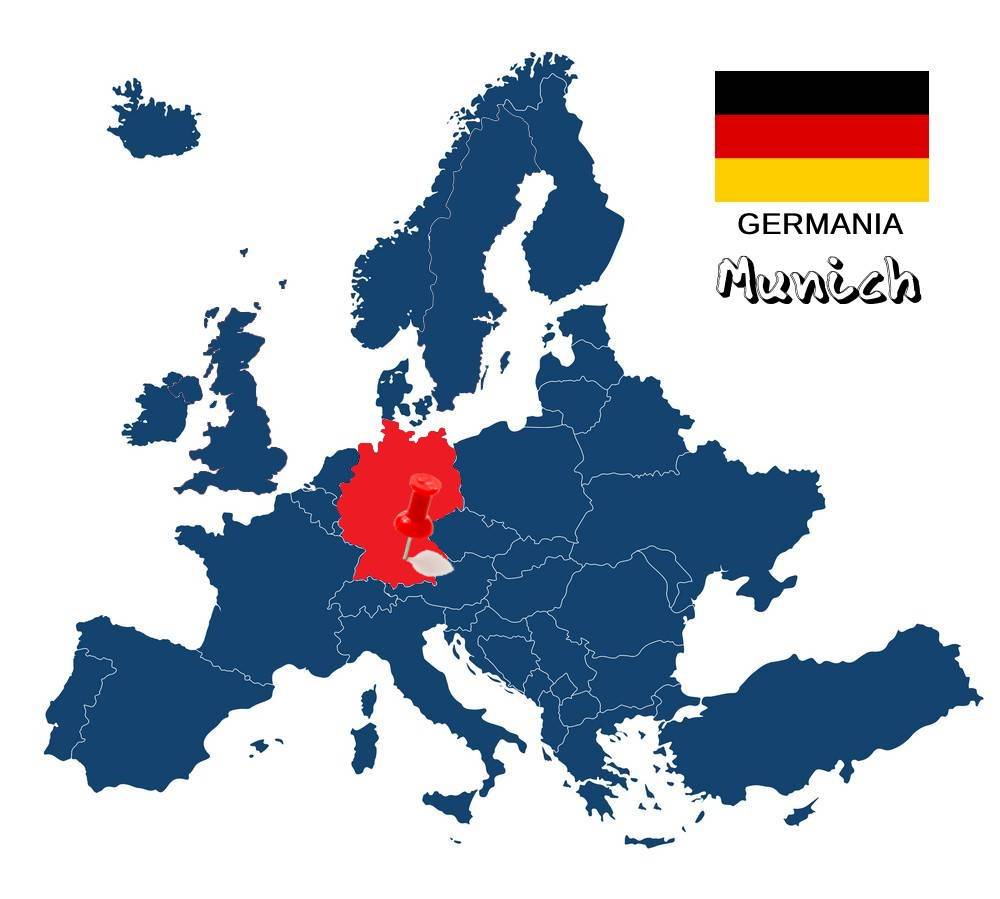
Munich deservedly claims the crown of the most attractive city in Germany. A cosmopolitan metropolis with a rich history, full of impressive squares, green parks, famous museums and of course plenty of beer!
A few words about the city
Munich is a city in southeastern Germany and is the capital of the state of Bavaria. It is built on the banks of the Isar, one of the largest tributaries of the Danube, and its name comes from the old German term Munichen, which means "from the monks". It comes from the monks of the Benedictine order, who built a monastery on the site that later became the old city of Munich, hence the monk depicted on the coat of arms of the town! It is the third largest city in the country, after Berlin and Hamburg, with a population of 1,350,000 inhabitants within the city and about 5,000,000 in the wider metropolitan area. It is also a major commercial and industrial hub, operating as a road, rail and air transport hub throughout Europe. The cultural contribution of the metropolis of Munich is equally important because it is home to many higher artistic institutions, numerous museums, as well as some of the most renowned universities such as the University and the Polytechnic of Munich. Of course, the city is famous for the beer festival that takes place there every year, the Octoberfest, which is visited by 3 million people annually that is twice as many as the permanent residents of the urban area! So I have chosen for you, what I consider to be worthy of attention for someone who is visiting the city for the first time.
Marienplatz
If we were looking for the most central point of Munich, this would be without a second thought the Virgin Mary Square (Marienplatz). This square was founded in the 12th century (1158) and took its name from the "column of the Virgin" that was erected at that point in 1638 as a sign of gratitude for the end of the Swedish occupation. There you will find some of the most important sights of the city, with the most important being the imposing New Town Hall (Neue Rathaus). This neo-Gothic masterpiece features a famous clock, the Glockenspiel, for which crowds of tourists flock daily to admire it. Twice a day until March (11 a.m. & 12 p.m.) and once from October onwards (5 p.m.) its bells ring and a unique show takes place that you should not miss! In addition, except the last two years due to a pandemic, the Marienplatz is also home to Munich's much-anticipated Christmas market, with dozens of shops selling handicrafts, local snacks and mulled wine. Finally, from there begins the largest shopping street in the city, the Kaufingerstraße where you will find literally everything!
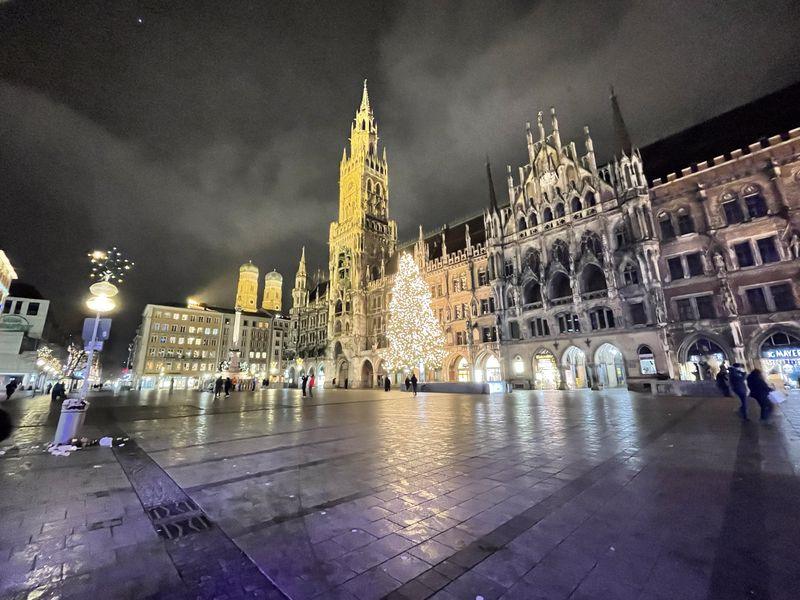
Maximilianeum
One of the most charming buildings in Munich is called Maximilianeum, as it started building on the initiative of King Maximilian II in 1857, with Friedrich Bürklein as its chief architect. However, some static problems of the ground delayed its completion until 1874 and the facade, which had been conceived as neogothic, had to be altered. Gottfried Semper undertook the adjustments, resulting in the final almost Renaissance appearance of the building, decorated with arches, columns, mosaics and niches filled with busts. The Maximilianeum was originally used as the home of charismatic students, but since 1949 it has housed the Bavarian parliament! Today you can visit the palace and admire the permanent exhibitions hosted in its halls or even see the parliament area if you have planned it before.
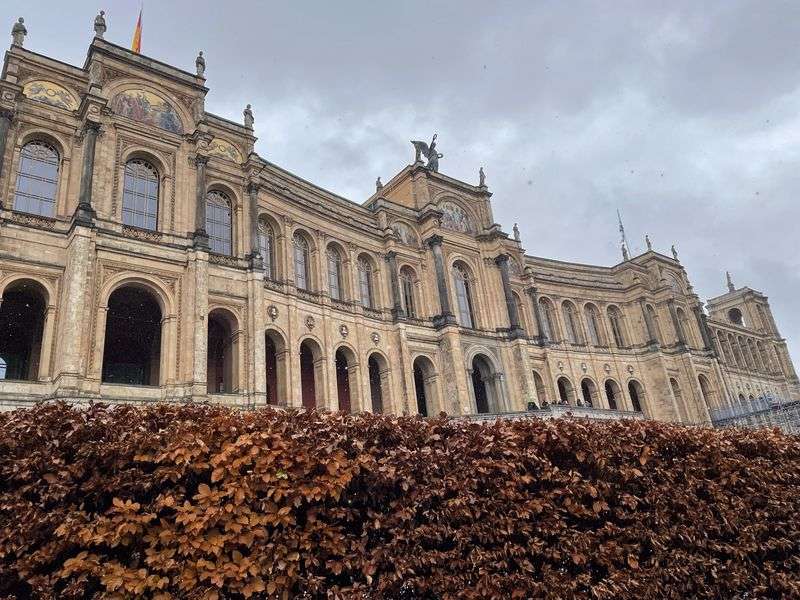
Residenz- Nationaltheater
The Residenz in the centre of Munich was the royal palace of the Wittelsbach monarchs of Bavaria from 1508 to 1918. It is the largest palace in the city and one of the most important museums of interior decoration in Europe, with visitors rushing to admire its impeccable architecture, the decoration of its 130 rooms and the exhibitions from the former royal collections. During World War II it suffered many disasters, but with the contribution of all it was renovated and restored to its early glory! The entrance to the museum costs 9e, while will have to pay more if you want to see the treasury!
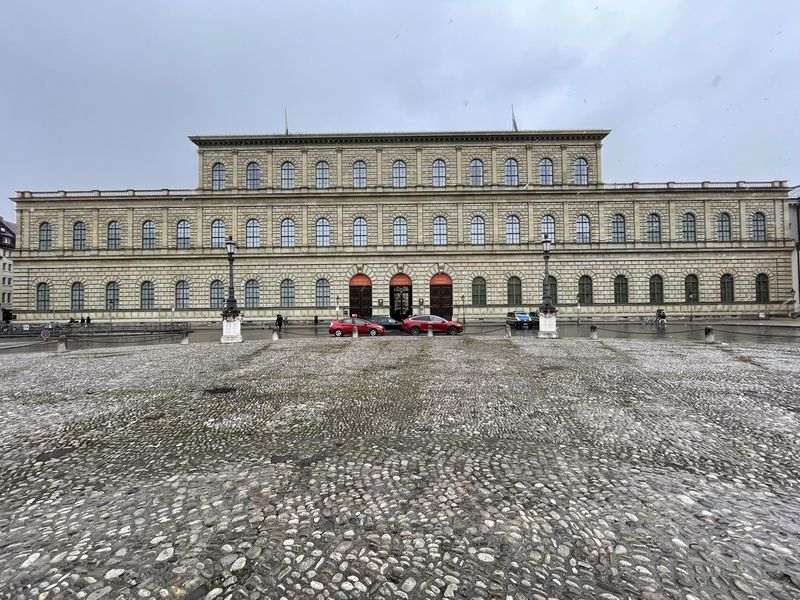
The palace garden (Hofgarten) was built between 1613-1617 by Maximilian I, Elector of Bavaria in the style of an Italian Renaissance garden. In the center of the garden, is a monument dedicated to the goddess Diana, created in 1615 by Heinrich Schön the elder. A path leads to each of the eight arches, while on the roof of the monument; there is a replica of a Bavarian sculpture by Hubert Gerhard, created in 1623. The original is located inside the Residenz.
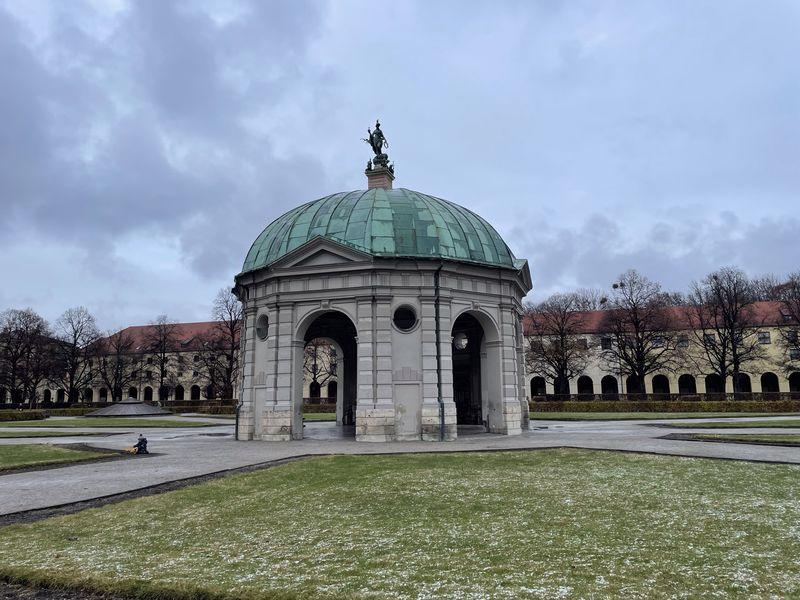
Next to the imperial palace you will find another impressive building, the National Theatre of Munich (Nationaltheater). It was founded in 1818 in the period of Maximilian the 1st, but like the Residenz it was partially destroyed in World War II. This building is of particular architectural interest, as it harmoniously combines ancient Greek features, Baroque elements and Renaissance influences. Today it houses the Bavarian State Opera, so if you are lovers of this particular type of music do not miss the opportunity to visit it.

Odeonsplatz
Behind the Royal Palace you will find another pleasant and historic square, the Odeonsplatz. It was designed in the early 19th century and took its name from the former Odeon Concert Hall on its northwest side. A deadly armed clash took place in this square, which ended the march to Feldherrnhalle during Hitler's Nazi Coup in 1923.
And if you are wondering what Feldherrnhalle is, I will immediately answer the question for you. The Marshal Hall is a monumental building, designed according to the model of the Loggia dei Lanzi in Florence! It was constructed between 1841 and 1844 by the famous architect Friedrich von Gärtner, by order of King Louis I of Bavaria to commemorate the tradition of the Bavarian Army. Two mighty stone lions guard the monuments of generals Count Tilly and Prince von Wrede, as well as the monument to the Bavarian army. What few notice is that the two lions have a different attitude and this is no coincidence. One lion, the one looking towards the Royal Palace roars, as a symbolism for the reaction to power, while the other lion, with his mouth shut, looks towards the church, as a sign of respect.
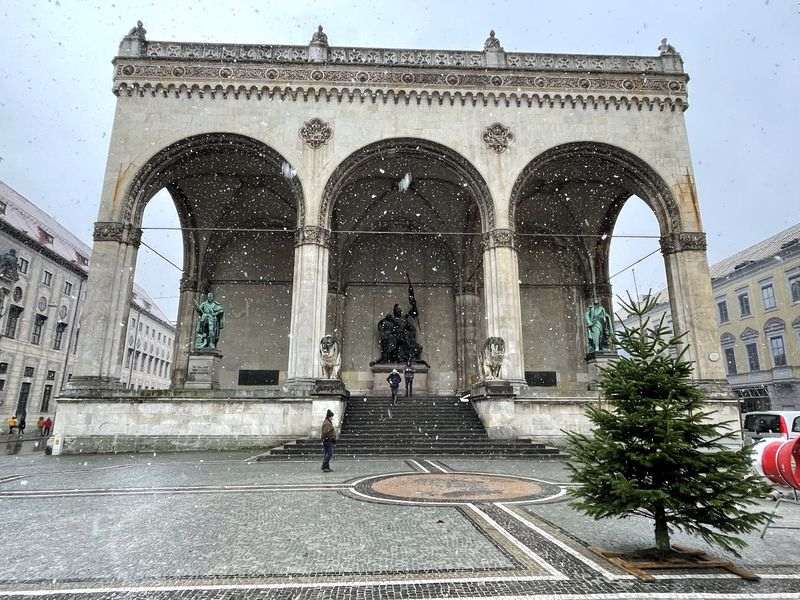
Finally, the temple in which the second lion looks is called the Church of the Theatinerkirche and will draw your attention with its impressive yellow color! It is a Catholic Church, built in 1663 to 1690 and founded by elector Ferdinand Maria and his wife, Henriette Adelaide of Savoy, as a sign of thanksgiving for the birth of the long-awaited Crown Prince of Bavaria, Prince Max Emanuel, in 1662.
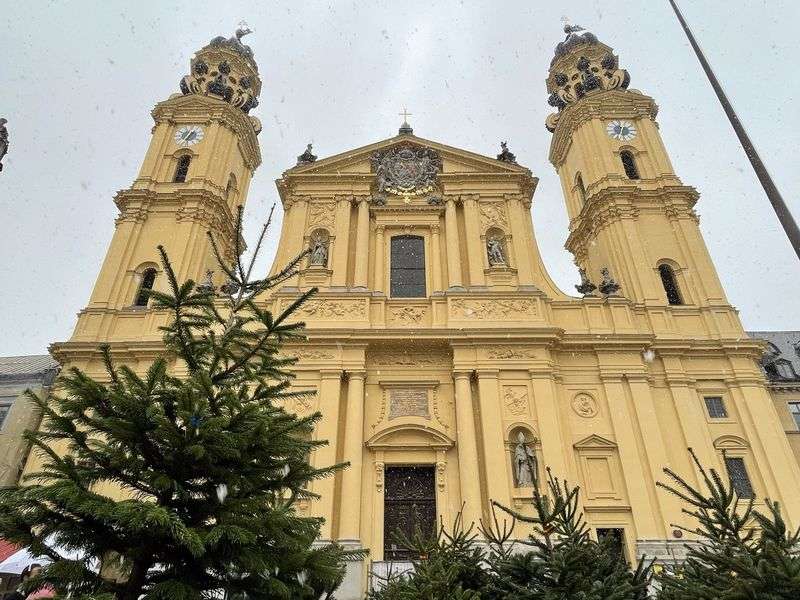
Nymphenburg
The great Baroque palace of Nimphenburg (Schloss Nymphenburg), on the northwestern outskirts of the city, was originally the summer residence of the Bavarian monarchs. Spread over more than 600 meters, this enormous palace is surrounded on each side by the homonymous canal, which splits as it passes through the main buildings before being reunited in front of the main facade. In this palace you can admire the elaborate frescoes, the gallery with paintings of local beauties and the hall with mirrors, decorated in Rococo style, which is truly breathtaking. It is worth visiting during the spring the magnificent gardens of the 17th century, which will be colorful by the hundreds of flowers and adorned with marble statues of Greek gods. In the gardens you will even find a large fountain and a number of greenhouses, including the Palm House, which has Germany's first hot water heating system. Admission costs 8e.
Englischer Garten
The English Garden (Englischer Garten) is one of the world's largest urban gardens, larger even than New York's Central Park and located in the northeastern part of Munich. The name is fooled, as it is not some English donation or intervention, but refers to the style of informal landscape gardening, which was popular in Britain from the mid-18th century to the early 19th century. Throughout the year, whether the weather is good or not, you will see many locals enjoying their walk, lying on the grass, having picnics, playing games and exercising! But in this park there are still plenty of things to see and do. Starting from the 25-meter wooden Chinese pagoda (Chinesischer Turm), continuing with the artisan Lake Kleinhesseloher See and ending at the top of a hill, where there is a Greek-style temple, called Monopteros. Finally, at the southern end of the park, on the Eisbach tributary, there is an ideal spot for surfing! So, all over the year (even when it snows), you will meet experienced and novice surfers who are trying to master various tricks.
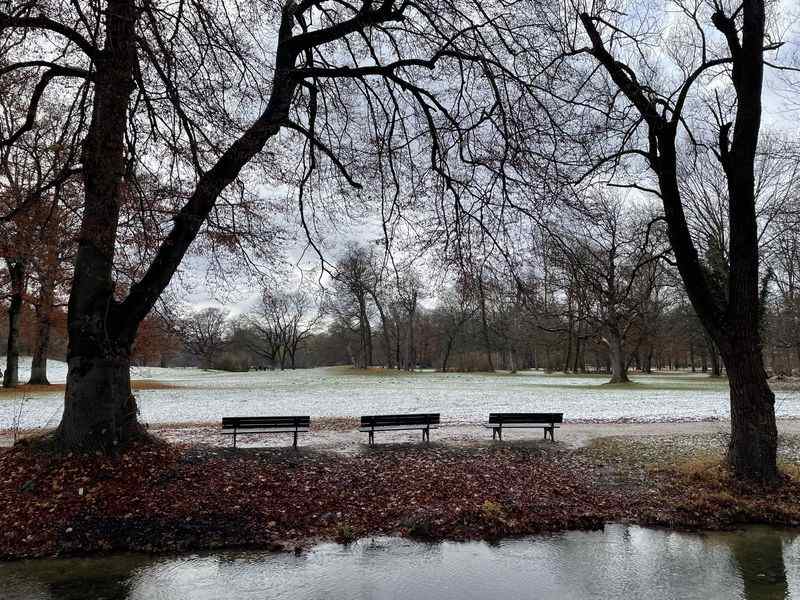
Westpark
The other park in Munich is called Westpark, as it is located in the western part of the city. It was designed by architect Peter Kluska and completed in 1983, while the same year it hosted the International Garden Expo. The park covers an area of 720,000 m2 and is divided into several thematic sections. First you will see the Asian gardens. These are four of the original 23 national gardens in the exhibition, preserved to this day. The first of the four is the Chinese and is the first authentic Chinese garden! The Japanese garden was a gift from the sister city of Munich, Sapporo and combines elements from the Heian period. The third garden has a Nepalese pagoda, which was carved by 200 craftsmen, while the Thai one houses the first statue of Gautama Buddha in Germany. Ultimately, at Westpark you will also admire the rose garden, which consists of more than 20,000 roses and 500 different species, as well as an artificial pond, which hosts outdoor movie screenings, live music and theatrical performances during the summer.

The churches
Munich's Old Town has some dazzling churches that you should not miss. I suggest you start with the Cathedral of Our Lady (Frauenkirche), which is a symbol of the whole of Bavaria! It was built during the 12th century in Gothic style, and today is the largest church in the city and its tallest building. In fact, the authorities have banned the construction of buildings that exceed 109 meters within the boundaries of the historic center! Inside the Frauenkirche vestibule there is an unusual tile that contains a black imprint, said to be the Devil's step! There are several legends surrounding the imprint, but the basic story is as follows. In 1468, the architect Jorg von Halsbach made an agreement with the Devil. The Devil would provide funds for the construction of the church if the architect did not put windows in the building, creating a celebration of darkness. After the completion of the building, the Devil entered the church to examine the result. From the vestibule, not a single window was visible, although the temple was flooded with light. The Devil was pleased with the result, but as he went further into the church, he realized that he had been deceived and in an outburst of rage, he struck his foot on the ground, leaving a mark on the floor. He then left the church and was transformed into a great spirit of winds, which rushes around the church towers to this day.

Another notable temple is the Church of St. Peter (Kirche St. Peter). It is a Roman Catholic Church dating back to the 14th century and which was severely damaged in World War II during the Allied bombing of Munich. The 91-meter-long tower is commonly known as the “Old Peter” and is considered emblematic of Munich. Still, this particular church is the oldest recorded Parish Church in Munich and probably the starting point for the entire city! If you manage to climb the nearly 300 steps that lead to the top of it you will get the best view in the city.
Finally, even more spectacular, perhaps, is the baroque grandeur of the Lilliputian Asamkirche, dedicated to Saint John Nepomuk. The church was erected in the period 1733-1746 and was financed, designed and built by the Azam brothers, the best known architects of the Baroque era. It is one of the most impressive examples of Baroque in the whole of Europe, while its interior is an excellent example of illusionism. The exuberant architectural details, plaster decorations, murals and games of light and shadow combine to create the illusion of a rhythmic ripple. Entrance to all three temples is free!

The Museums
If you are a fan of museums then Munich will not disappoint you! The Art Neighborhood (Kunstareal) brings together some of the most interesting museums in all of Germany! Start at the Old Gallery (Alte Pinakothek), which contains over 700 European masterpieces (entrance costs 7e) and continue with the New Gallery (Neue Pinakothek) (entrance costs 7e) and the Modern Gallery (Pinakothek der Moderne), where you will admire paintings from the Middle Ages to works of today (entrance costs 10e). If you plan to visit them all, you can just issue a ticket for all that costs 12e.
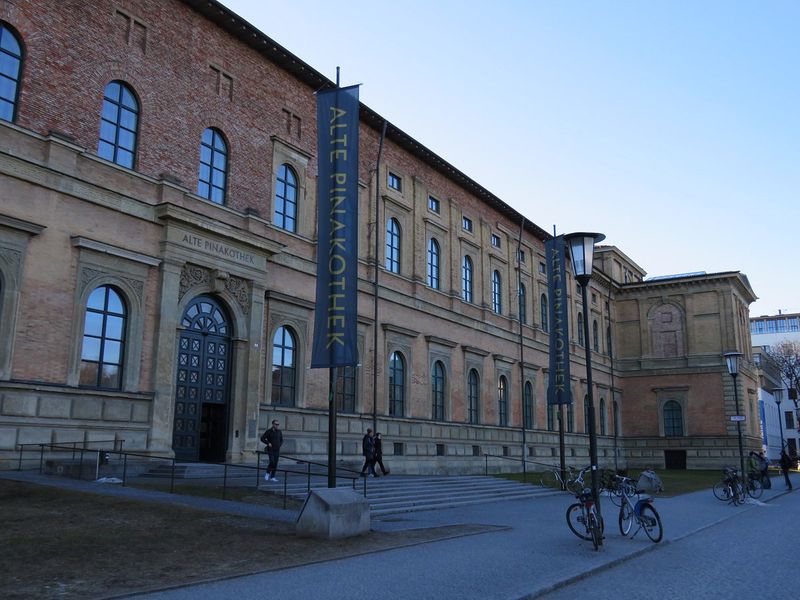
Special mention also deserves the neighbouring Brandhorst, which impresses both with its imaginative architecture and its special exhibits (entrance costs 7e). It is also worth visiting the Glyptothek, where the Metope of the Temple of Aphaia Athena of Aegina is on display (entrance costs 6e) and the National Museum of Bavaria (Bayerisches Nationalmuseum), which is one of the most notable museums of Decorative Arts in Europe (entrance costs 13e).
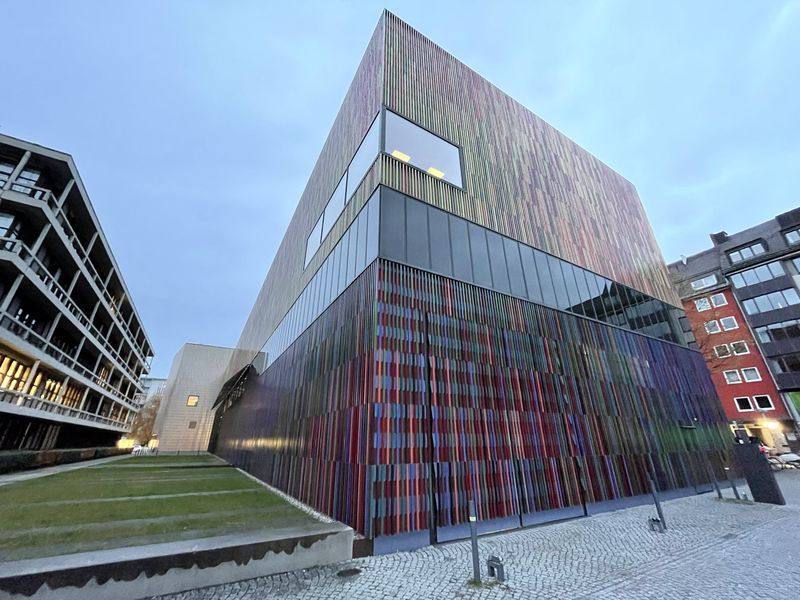
And of course, since you are in the birthplace of the legendary car industry, do not miss the opportunity to visit the BMW Museum. There you will admire some of the most impressive models of the company, while the spectacle continues with periodic and permanent exhibitions in the adjacent BMW Welt showroom, but also the company's factory, during the tour where you will learn exactly how about 950 vehicles are produced per day - from the frame to the paint. Admission to the 10e costs while at the BMW Welt it is free.
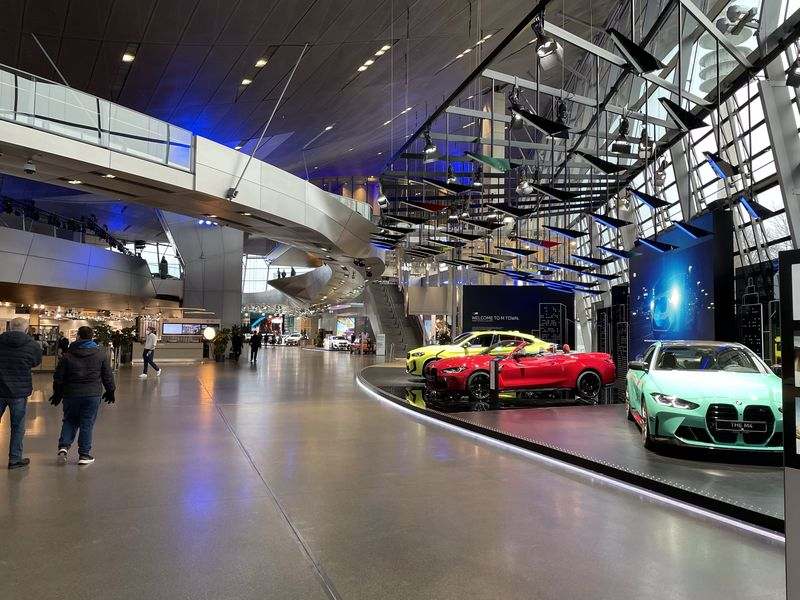
Finally, do not miss the German museum (Deutsches Museum), which is the vastest museum of Science and technology in the world with about 28.000 exposed objects from 50 fields of Science and technology. In fact, it is estimated that it receives about 1.5 million visitors per year. Admission costs 14e.
Olympiapark
The Olympic Park (Olympiapark) was built from scratch on the occasion of the 1972 Summer Olympics and remains one of the top attractions of Munich. It is located in the Oberwiesenfeld neighborhood and currently serves as a venue for cultural, social and sporting events. Olympiapark surpasses all expectations as a park. In addition to the usual grass hills, ideal for picnics on a sunny day, there is a swimming pool, an ice rink, an aquarium, a cinema by the lake and an outdoor performance area, an Olympic arena and a football field, and of course the Olympic Tower (Olympiaturm). I suggest you climb to its top to admire the view from 190 meters or sit down to eat in the revolving restaurant that rises lower, at 181 meters.

Theresienwiese
Theresienwiese is a huge open space, which serves as the official location of the Oktoberfest in Munich. It is an area of 420,000 square meters, bordered on the west by the Ruhmeshalle and the statue of Bavaria (Bavaria Statue). This statue is a female personification of the Bavarian homeland and consequently of its power and glory. It was considered and is considered to this day a technological masterpiece. Due to its size it had to be produced in many places, having a height of 18.52 meters and a weight of about 87.36 tons! An internal circular staircase leads to a platform at the head of the statue, where four openings in its helmet overlook the center of Munich.

Finally, very close to Theresienwiese and the statue of Bavaria, there is a well hidden special attraction. In the courtyard of KPMG headquarters, you will find a staircase that leads nowhere. The Endless Staircase is a sculpture by Danish artist Olafur Eliasson, finished in 2004 and symbolizes life which is not a destination, but a continuous movement.
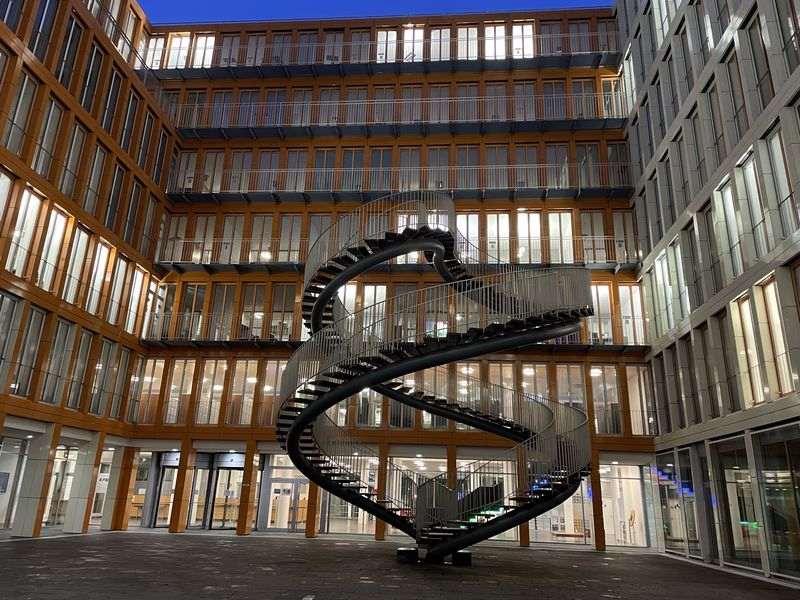
How to go
Thessaloniki is connected by air to Munich and Munich International Airport via several companies. The most advantageous option comes from Aegean, where with proper planning one can find tickets starting from 105 € round trip! You can also choose a Lufthansa flight for 116 € round trip. Beyond that, there is also the prospect of going to a nearby city such as Nuremberg or Baden-Baden (via Ryanair) and from there approaching the city by bus or train.
Where to stay
Munich, although it is a central European city, is not so expensive in the area of accommodation. There are plenty of options both in and out of the city, which are easily accessible since the transport network is quite good and favors fast travel. So my suggestion is the Boutique Hotel Atrium München, a boutique hotel, just outside the city center, fully equipped with anything you may need!
How to move
Public transport in Munich is based on four pillars: the metro (U-Bahn), suburban trains (S-Bahn), trams and buses. The six metro lines are joined in many places with their suburban eight, covering all the lengths and widths of the city. And for any gaps, there are still thirteen tram lines and hundreds of buses. Still, Munich is very cyclist friendly, so renting a bike or skate is a very good idea. As is easily understood moving is something that you should not be particularly concerned about in the Bavarian capital!
What to eat
Bavaria has a long-standing culinary tradition and its own cuisine, Bavarian. In fact, it is considered the best in Germany and one of the most delicious in Europe. It includes rural simple and hearty dishes, with plenty of meat, sausages and pastries. The most popular snack in the area is, of course, the pretzel, while from savory dishes you should definitely try white Bavarian sausages Weißwürste, sauerkraut, Käsespätzle (a type of pasta with cheese), schnitzel, Schweinshaxe (pork shank), Leberkäse (a type of smoked meat mix) and Wurstsalat (salad of sweets), do not miss Kaiserschmarrn (something like the greek bougatsa), apfelstrudel (Apple Strudel), germknödel (Bavarian pasta) with vanilla sauce and schmalznudel (Bavarian donut). As for the drinks, I think I don't even need to mention that you should drink beer! For a very good burger, I recommend the King Loui, for schnitzel the Spezlwirtschaft Haidhausen, for pizza the L'osteria Kunstlerhaus, for Asian QYU Restaurant, for Mexican Los Companeros, for coffee the Café Zeitgeist and for beer the Hofbrauhaus.
Useful information

In Germany we travel with a passport or a new type of Police ID, where the details are indicated in Latin characters.
In Germany the language used is, of course, German. But the majority (mostly young people), speak English, so ask for clarifications in English.
The currency of the country is the euro.
Munich is an hour behind Greece (GMT +2).
The Greek unpaid Consulate General in Munich is located on möhlstr Street. 22, 81675 and his phone is + 49 89 998867-222, -23, -14.
Getting to and from Munich Airport is simple, since there are continuous train services, lines S1 and S8! There is also the Lufthansa bus that runs 365 days a year and you can use it regardless of which airline you fly, as well as various public buses!
Germany has very low temperatures and a lot of snow during the winter months, but Munich is magical during Christmas. A good time to visit the city is the end of September to the beginning of October, when Oktoberfest takes place, while the ideal period for Munich is spring when all its parks are blooming
Recommended Excursions → Nuremberg, Stuttgart, Salzburg

If this article seemed interesting or contributed to your quality information, then you can like my facebook page: o_thessalonikios or follow me on instagram!
Mouzakidis Pantelis








